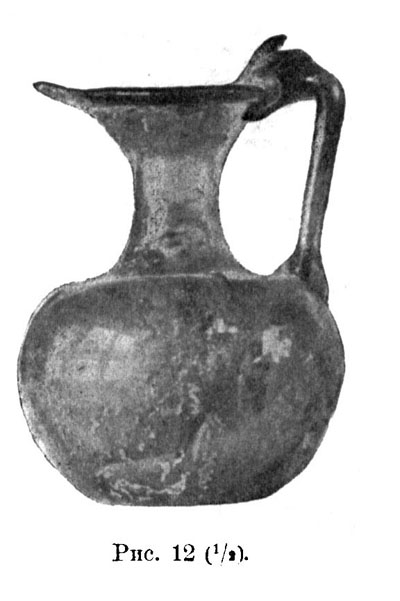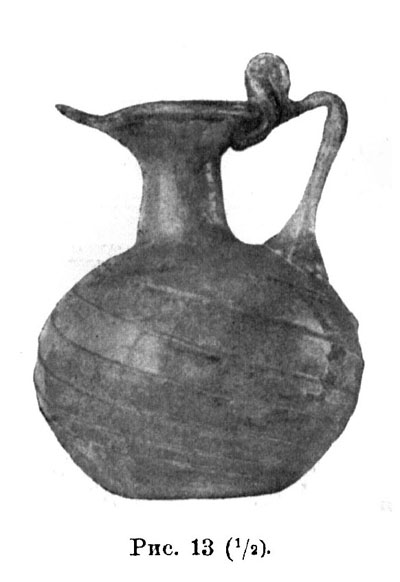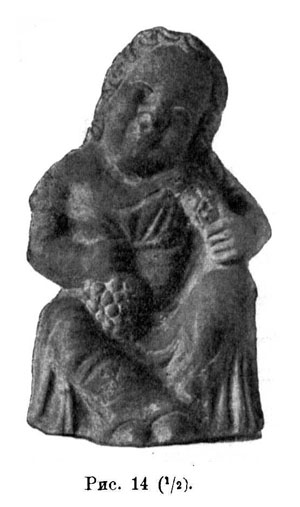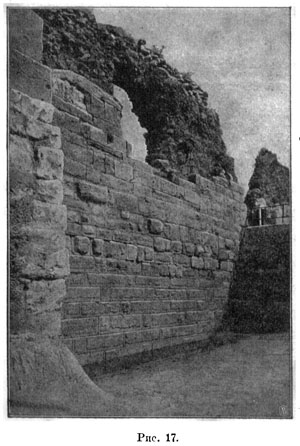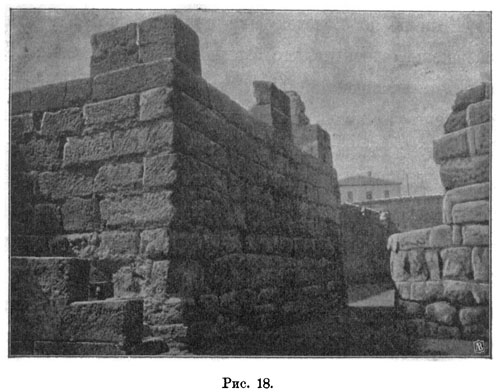REPORT FOR THE IMPERIAL ARCHAEOLOGICAL COMMISION OF YEAR 1899
1.Tauric gubernia
а) Excavations in Tauric Chersonesos
In Chersonesos, in the year under report, the Commission's corresponding member K.K.Kostsyusko-Valyuzhinich has concentrated his efforts in both one and another side of the part of the ancient wall which is located between present monastery gate and a breach serving as a communication with Karantinnaya bay and Warehouse of Local Antiquities, and in the strip of the ancient city site adjacent to the city side of this wall.
[1]
In continuation of the works started in 1898 at the exterior side of the city wall
[2] .
Mr Kostsyusko-Valyuzhinich has made complete, down to bedrock, investigation of the area immediately adjacent to
the wall. The works were started at the distance of 8.50 m fare from the monastery gate. The excavations have
uncovered ancient gate of Chersonesos of superior preservation, with vertical grooves on sides for crossbeams
(Fig.1)
under wicket а
(see its plan on Plate I)
|
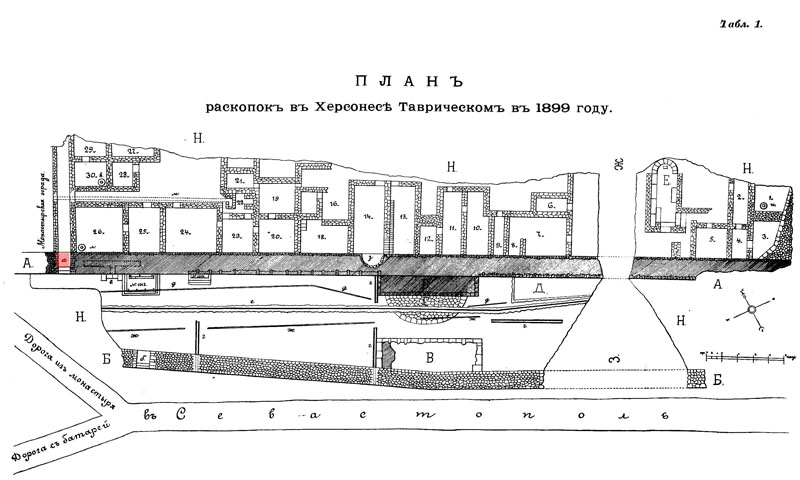
|
The bedrock against which the gate foundation is placed there raises above the sea level at 2.15 m and
greatly inclines to the south, towards Karantinnaya bay. A thick slab leaned to the wall uprightly has been discovered
at a distance of 3.90 m to the south from the gate span; its bottom was sunken into the bedrock, and the slab itself
was probably located lower than the level of the ancient road that went at the wall. The slab did not abut the wall
closely; the hole that remained between it and the wall was plastered with clay, after removing of which a gold badge
that served to decorate cloths, with gorgoneion, has been found. Through the appearing chink they saw fired bones,
charcoal, and ash. Having removed the slab, Mr Kostsyusko-Valyuzhinich has opened a passageway under the city wall
of 0.75 m high, 0.53 m wide, and 1.42 m long(Fig. 2)
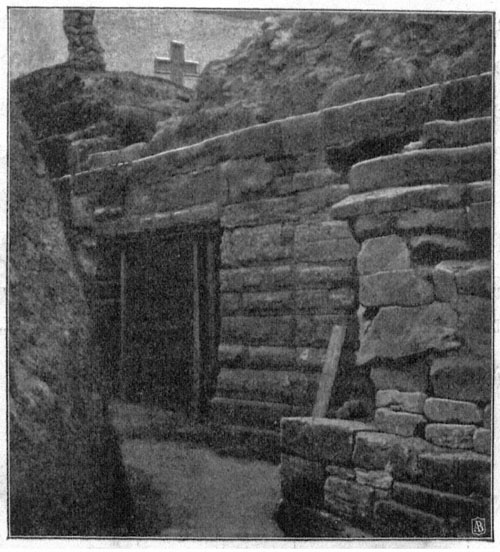
|
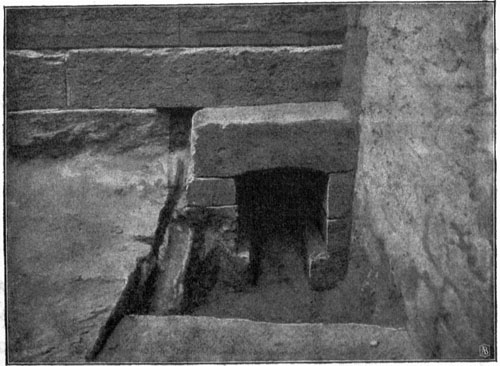
|
| Fig. 1 |
Fig. 2 |
Solid gold finger-ring, fragment of a thick gold badge, two gold rectangular badges depicting Pan's head, 4 badges
depicting acanthus flower, gold hornlet, 8 glass circles, 16 terracotta decorations with traces of gilding, 52
terracotta balls of different size with traces of gilding, 36 fine bone fragments, and 54 small bronze nails were
excavated there amidst fired bones. There obviously was cremated burial. The passageway mentioned leads to a corridor
placed in the wall and located perpendicular in relation to the entrance
(Fig. 3);
the corridor length is 7.55 m, width is 0.62 m, height is 0.89. The corridor floor is cut into bedrock, its walls
and ceiling are made of big, smoothly hewn and excellently adjusted slabs without cement. In the walls under the
ceiling on both sides of the corridor there are 16 rectangular niches (0.18 m deep, 0.13 m wide and deep each) facing
one another. These niches were obviously aimed to preserve transverse bonds that, however, were not put in. These
niches and the technology of the building in general clearly indicate that the corridor was erected during the very
building of the wall and gate. 6 vessels of the form that is used to be called hydria, located as indicated on the
plan (Fig. 3)
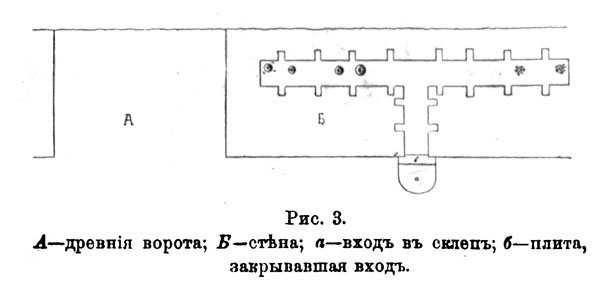 |
were found in the corridor:
- in the left half of the corridor there were 4 (of which 3 clay hydriai and 1 bronze one) and in the right half
there were 2 (bronze ones). The first in the left half stood black slip hydria with lead lid decorated with ornaments
made by light-brown colour in the middle and around its neck. Both the shape of the vase and its decorations clearly
indicate that it is no later than the fourth century B. C. In the vase, there were fired bones and the following
gold jewelry
[3]:
- necklace of high artistic quality and excellent preservation, 2) pair of earrings,
- pair of earrings,
- finger-ring depicting Athena and Nike, and
- smooth finger-ring.
All these artifacts are of the late fifth or early fourth century BC according to the style. Gold finger-ring
depicting bow and bludgeon has been found in the second clay hydria (not black slip one) that was also covered with
lead lid; but only fired bones were in the third one (similar to the second), all the same as in the bronze hydria
that stood in the left half of the corridor. Small clay cup and terracotta statuette of Eros
(Fig.4) have been also found in the same half.
On one of the bronze hydriai (that remained very badly), which are discovered in the right part of the corridor,
around the hole, there is an inscription άθλον έξ Άνακίων,
«Prize of (festival of) Anakes»
(Fig.5).
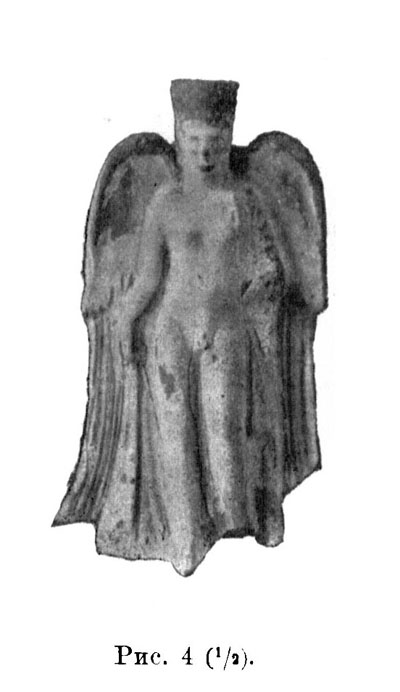
|
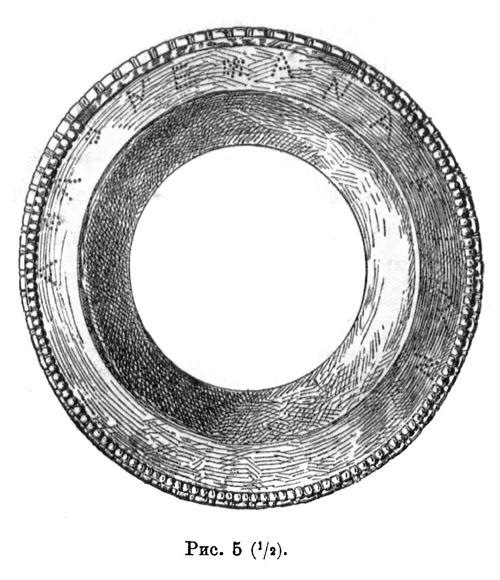
|
| Fig. 4 |
Fig. 5 |
|
This hydria contained fired bones and the following artifacts:
a) gold:
- two rectangular gold badges with Gorgoneion,
- five rectangular badges depicting Pan's head,
- 4 badges depicting acanthus flower,
- finger-ring,
- two necklaces,
- pair of outstanding pendants of extraordinary fine workmanship,
b) sliver:
- two twisted bracelets,
- finger-ring depicting Aphrodite's head and two Erotes.
|
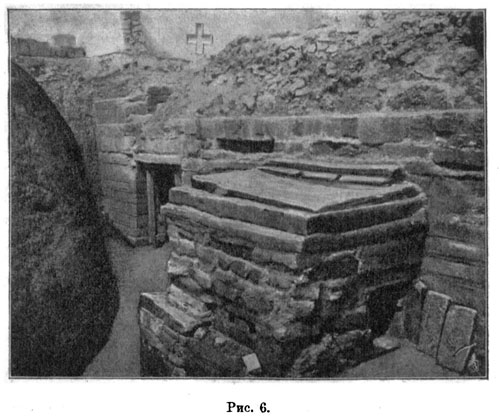
Fig. 6
|
|
Only fired bones are found in the other hydria in the right half of the corridor. The artifacts found in the
right half of the corridor can be related to the late fifth or early fourth century BC as well. Aggregate of
all finds from the corridor and passageway leading to it clearly indicates that the builders arranged a vault
there exactly when they were constructing the walls[4].
Large family vault [5]
(Fig.6)
|
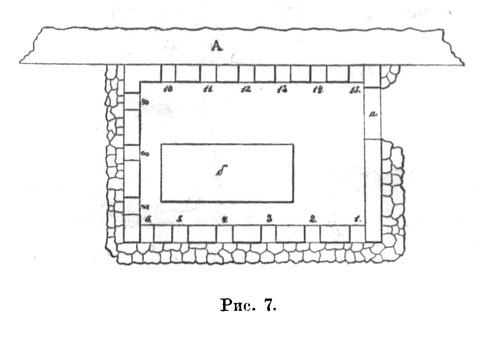
Fig. 7
|
with the entrance in its south side (h[eight] 1.05 m, w[idth] 0.80 m) has been discovered at the distance of
4.60 m from wicket a, at the very wall, a bit lower than Byzantine level. The floor in the vault is ground;
its gable ceiling and walls are plastered. Dimensions of the vault inside are: length 3.65 m, width 2.31 m,
height 1.05-1.78 m. 15 niches 0.24 m wide, 0.35 m deep, and 0.37 m high are located in the walls of the
vault.
Sarcophagus b (see plan on Fig. 7)
of 2.09 m l[ength], 0.84 m w[idth], and 0.53 m height stood inside the vault, in its north-western part, on
the floor. Remains of ruined lead coffin and decayed skeleton laying with the head to the north have been
discovered inside the sarcophagus. With the bones there appeared: big glass vessel, iron belt point, grinding
stone, and bronze coin (Burachkov, XVI, 120).
Decayed skeleton with the head to the entrance laid on top of the sarcophagus, on the slabs. It was placed
originally in wooden coffin from which only fragments of nails remained. With the bones there were found:
- gold finger-ring with Oriental garnet,
- pair of gold earrings,
- agate elongated bead with wide aperture,
- amber bead with wide aperture,
- glass balsamarium,
- small clay red slip lamp in the form of human head
(a - side view) and
(b - front view).
|
|
8 of 15 niches also contained various ancient artifacts: clay urns (in which there were fired bones), two gold
leaflets, gold neck hoop, fragments of plated gold, part of gold earring, gold badges, gold finger-ring, gold
pendant, 4 paste beads, bronze mirror, bronze cup that suffered much because of oxidation
(Fig. 9а),
with the handle decorated with dog's head on the top (Fig. 9b),
and Medusa head in the bottom, at the junction with the vessel (Fig. 9c),
two small terracotta toy-bulls (Fig. 10 and
Fig. 11),
clay red slip vessels, vessels of simple clay, small clay lamp, glass vessels, fragment of iron knife,
silver thimble, coins of the Roman imperial period (by the way, of the emperor Titus).
|
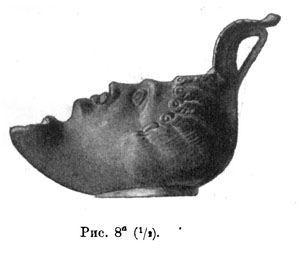

Fig. 8a Fig. 8b
|

|
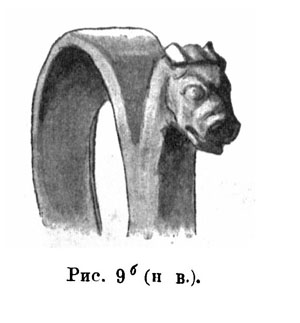
Fig. 9b
|
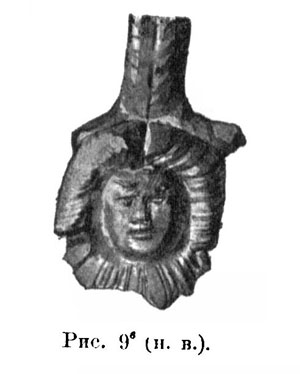
Fig. 9c
|
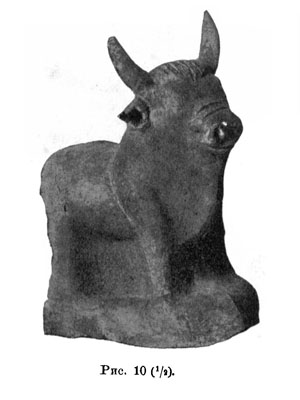
|
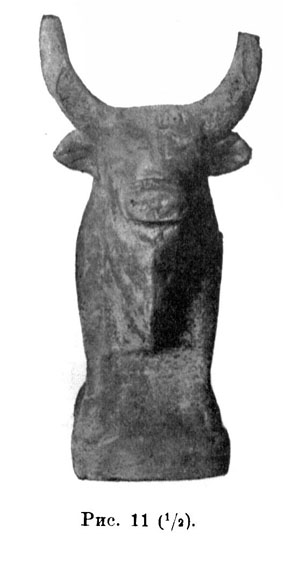
|
| Fig. 9a | Fig. 10 | Fig. 11 |
Two skeletons with the heads to the north-west laid in the left from the entrance corner, and opposite to the
entrance, between the right wall and stone sarcophagus, there were three more with heads oriented to the north-east.
There also were skeletons and various artifacts found on the floor of the vault: 2 small glass ewers of beautiful
form, one of them of violet glass
(Fig. 12),
another of light green
(Fig. 13),
small marble mortar, solid silver leg hoops, bronze mirrors, lead urn (that appeared to contain fired bonus, gold
pendant, 8 pieces of thin plated gold, and two glass balsamarii), fragments of other lead urns, terracotta
statuette depicting seating girl with bunch of grapes in one hand and small bird in another
(Fig. 14),
clay small lamps and vessels, clay urn (in which, beside fired bones, were found: a part of gold oval eye-plate
with image of pupil encircled with wreath, gold lip-plate with image of closed lips,
|
10 pieces of thick plated gold, broken iron strigil, and broken iron knife blade) rock crystal statuette of
a small hair, rock crystal icosahedron, a part of agate top decoration of dagger handle, bronze Eros-shaped
knife handle, a part of bronze buckle depicting two small battling cocks
(Fig. 15),
part of a bronze fibula (Fig. 16),
small bronze key, bronze ring, various bone and glass artifacts, shark's tooth used as amulet, gypsum child's
head, carved and plain stones from finger-rings and pendants, beads, various coins and gold jewelry. Under the
sarcophagus there were two slabs covering a pit in which big gold earring was found.
At the distance of 3.73 m from the south wall of vault no. 1013 second vault no. 1014, of the same construction
with the first one, but of smaller dimensions: 1.82 m long, 0.98 m wide, and 1.02 m high (in the middle), has
been discovered; entrance to this vault is located also at the south side and has height of 0.71 m and width
of 0.67 m. This vault was plundered already in the Byzantine times when placing clay pipes of water supply
that went just above the vault, in the distance of 0.18 m. 13 disordered clay urns are found in the vault.
Fired bones were scattered on the floor of the vault; to judge from there were a few bones in each of 9 urns,
all the bones originally were placed in the urns. 3 skeletons, all heads to northwest, laid on the floor of
the vault, in the south-western corner. Various gold jewellery, fragments of thick plated gold, glass and clay
vessels, various silver, bronze, and iron artefacts, small clay lamps, glass and amber decorations, different
beads, boar's fang (amulet), etc. have been found in the vault.
Remains of ancient water pipes d and e and of drain pipes
f have been found between the main city wall A and auxiliary wall B
(see the plan on Plate I)
They were destructed already in the Late Byzantine period when drain pipe g was constructed:
it has been
uncovered along the whole length of the excavated strip, without interruptions. An excellent example of the
ancients' art of wall-building is the lower tier of the wall of 6 courses processed as rustications, between
the breach and rectangular tower C
(Fig. 17). |
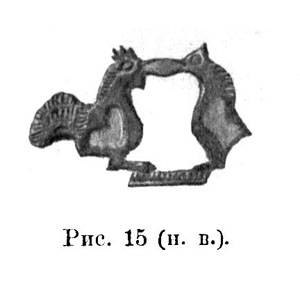
Fig. 15
|
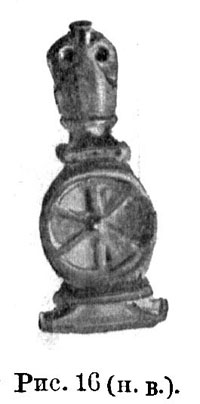
Fig. 16
|
If it is not clear why was the ancient Greek wall with the gate covered, it is absolutely evident that towers
В - В and D, wall B, wickets а and b, water pipes d and g,
drain pipes g and е, cistern D, and vaults nos. 1013
and 1014 were constructed already after that covering. Thick and laid of big stones wall B everywhere reaches
equal depth with that of the infill; it makes clear, partly plastered masonry only upper than the level of wicket b,
so it must serve as revetment for high artificial ground mound that served as necropolis in Roman period and had, it
seems, the only road that lead to the city going on top of it.
The following artifacts (apart from those found in vaults) have also been found during excavations between alls
A and B: three fragments of marble slabs with inscriptions
(one Latin and two Greek)[6],
368 various coins, fragments of marble an terracotta statuettes, fragments of various vessels of ancient Roman, Greek,
and Byzantine periods, 342 amphora handles with inscriptions, small marble fragmented mortar with pestle shaped like
bent finger, bronze arrowheads, throwing balls for catapults, part of bronze horse bits, sinkers for fishing nets
(some of them with stamped images), various fancywork, toilet, and decorative articles, and finally, various
architectonic fragments and uninscribed tombstones.
|
Excavations at the city side of the main wall A were conducted in the direction from the breach
G - H
(used to get to the wharf and warehouse of antiquities) to the ancient gate; it was decided to take off
soil by layers which allowed one to compile exact plans of areas that had been investigated in different
periods of the city life and to establish chronological classifications of discovered antiquities, but at
that, unfortunately, sometimes there was need to pull down some foundations and walls of Byzantine and,
partly, Roman buildings. Foundations of a small (10.57 m long and 5 m wide) church that served as a
sepulcher
(see symbol E on the plan)
have been found to the right from the breach, towards the bay, at the
distance of 3.55 m from the city wall. The church was built partly of materials which had been used before
and consisted of rectangular in ground plan nave and apse. 9 sepulchers laid of slabs have been discovered
in the church. Bones of 118 skeletons (judging by the number of skulls) have been found in them; it is obvious
that bones that had previously been kept in some other place were collected there. The sepulchers contained a
relatively big number of artifacts: 1) half of copper reliquary cross depicting crucified Savior who wears
chiton (this indicates that the period of the cross was no later than the ninth century) and busts of St. John
the Theologian and Mother of God on the sides, at the ends of the cross, with usual inscriptions:
ίδέ ό ν[ίό]ς Σου, «this is your son» and
ίδου̃ ὴ μήτηρ σου,
«this is your mother» (Fig. 20);
2) another reliquary cross depicting crucified Jesus Christ, with inscription
IC XC NIKA
3) various decorations and toilet articles;
4) fragments of knife and scissors;
5) coin of Rhomanus I (920-944) and Oriental coin.
|
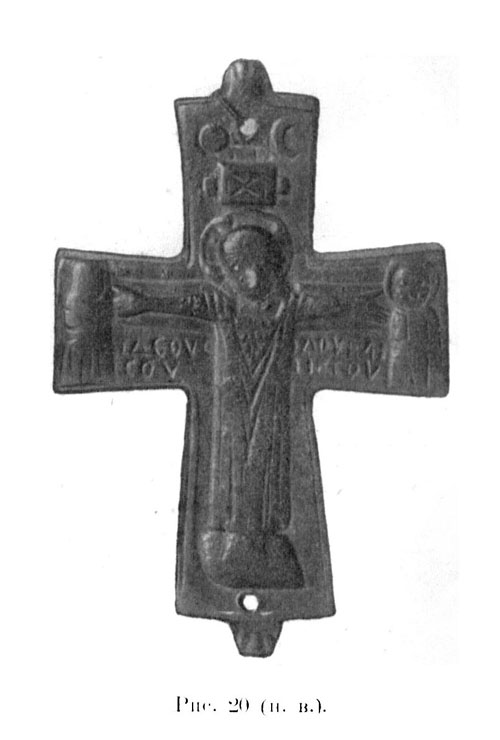
Fig. 20
|
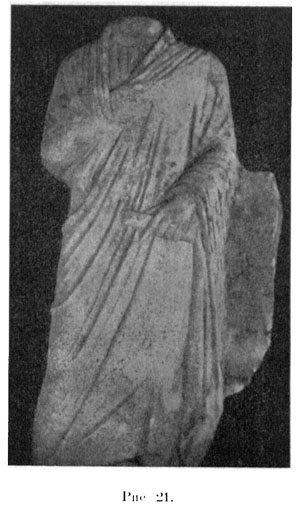
Fig. 21
|
5 living rooms have been discovered in the vicinity of the church described above
(1-5 on the plan).
Ball-shaped pithos (и) was buried in room no. 1.
(i).
Excavations to the left from the breach up to the wicket a have uncovered 25 living rooms more
(nos. 6-30 on the plan),
adjacent directly to the wall A from its interior side.
And these rooms are built partly of the material that was already used before. Here parts of old buildings,
inscribed slabs [7], fragmented ancient marble statue
(Fig. 21) were put into walls.
Drain pipe m has been investigated amidst these living rooms.
In rooms nos. 26 and 30 crushed clay pithoi k and l,have been found;the latter
one contained salted fine fish. A great deal of various antiquities has been found when clearing these 25 rooms:
fragments of inscribed stones, 218 different coins, fragments of clay and glass pottery and of marble and stone
utensils, different household articles, weighing mark, sleighing bells, various game articles, fancywork tools,
carved decorations and toilet articles, various articles of Christian cult (gold amulet-holder, crosses, diskos,
thurible covers, etc.), and various architectonic fragments.
After finishing excavations of the Byzantine layers, excavations of next layers were begun at the gate where
getting deeper, down to bedrock was started. Excavations of the ancient gate A
(see the plan at Fig. 22)
have got detailed guidelines for the construction of the gate and method of its locking. The gate's width equals
3.87 m (the socle projects a bit more at both sides) and the length is 8.89 m. Similarly to the ancient wall,
the gate is constructed of hard steppe limestone, that was mined not fare away from Chersonesos.
The gate's slabs keep also benchmarks (symbols of the fifth century ancient Greek alphabet).
|
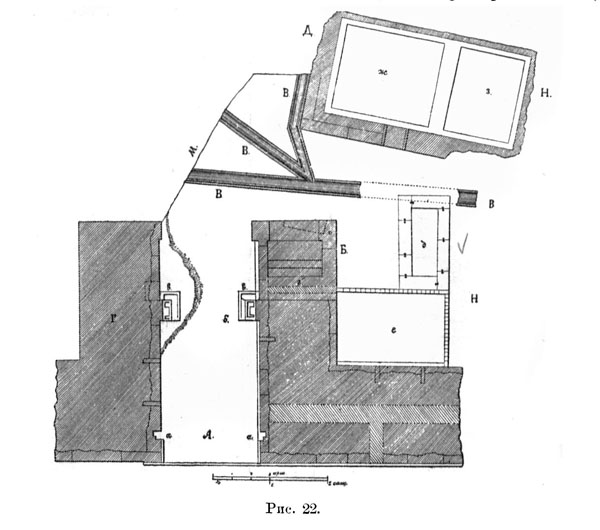
Fig. 22
|
Rectangular slots а - а (0.15 m wid[e] and 0.08 m dee[p]) that go straightly up were made at the distance of 0.75 m
from the exterior corners of the gate, at the height of 1.02 m above bedrock, within the gate. In the right wall of
the gate, the groove has the height of 1.77 m, in the left wall it has 2.31 m. It is likely that, in danger moment,
beams were put in these grooves, for which purpose one groove was made shorter than another one. Further into the
gate, at the distance of 5.33 m from the corners, two rectangular projections b – b remained
where double-leaf door was placed; the door opened inside, to the city; when locked, the door was supported by
a beam; when opening the door, the beam was slid into the wall to the right side from the gate, into rectangular
aperture specially made for this purpose
(см. Fig. 23 and
Fig. 24).
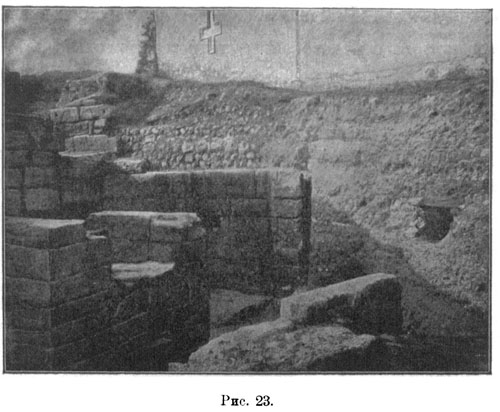
Fig. 23
|
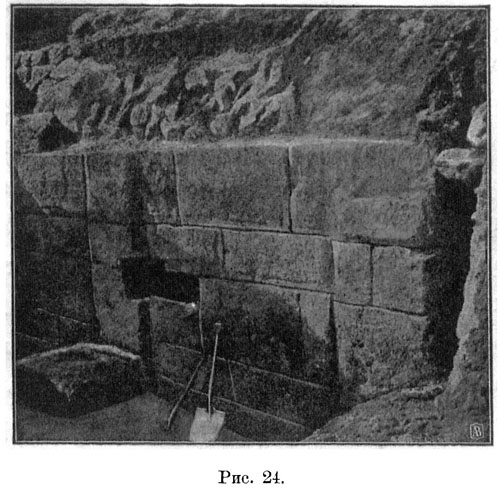
Fig. 24
|
|
Two living rooms connected by a doorway were arranged in the gate in the Roman period. Coming out the gate and
turning to the right, it was possible to go up to the ancient wall by stone staircase B of which only two
stairs survived till now. Drain canals made of unplastered stones with carved gutters have been uncovered
immediately at the gate
(Fig. 25),
for the part of this drain pipe that was transferred to the square near the warehouse of antiquities).
The canals converge to the gate from three different sides and show the directions of the three streets
(B – B – B) that went from the gate.
Wall of building D of the Greek period, that was fit for two cisterns g and h in the
Roman period, has been discovered near one canal.
Clay amphora and 5 pithoi (two of which, egg-shaped, have been found intact) were dug into the ground in pit h.
Main canal of complete network of city drain pipes B - B was destroyed when building draining well d
in the Roman period, at the distance of 1.07 m from the right, looking at the bay corner of the right side of the gate.
|
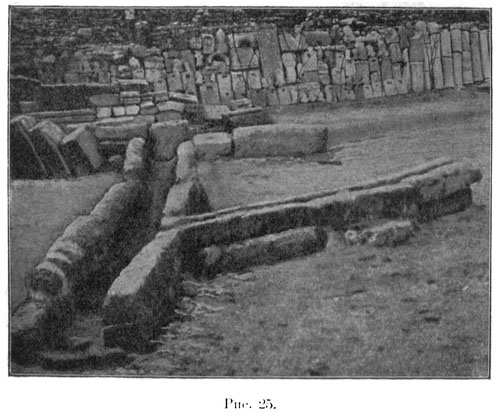
Fig. 25
|
The soil taken from the pit contained shreds of black slip pottery and right side of a small slab depicting warrior
and traces of Greek inscription of the Roman period. In the Roman period, the corner formed by the right side of the
gate and the city wall from the side of the city was fit forcistern e.
Different artifacts of the Greek and Roman period have been found when deepening down to the bedrock at the area near
the ancient gate: 166 various coins, fragments of terracotta statuettes, fragments of various pottery (some with
stamps and inscriptions), various types of weaponry, fishing sinkers, and different architectonic fragments.
|


















